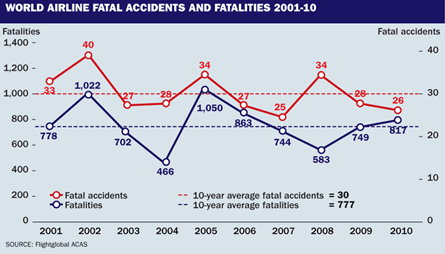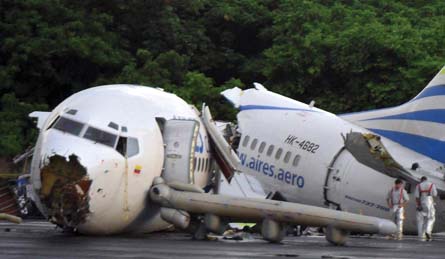In 2010 there were 26 fatal airline accidents (see tables below), causing the deaths of 817 passengers and crew. This spans all types of airline operation, including scheduled and non-scheduled passenger flights, jet and turboprop, plus non-passenger operations such as pure freight or positioning, and compares with 2009's figures of 28 accidents causing 749 deaths (see graph below).
An indication that global average airline safety could still be improved considerably comes from the performance of International Air Transport Association member airlines, whose accident rate fell dramatically last year. The hull-loss accident rate for IATA carriers flying Western-built jets dropped to an all-time low of 0.28 hull losses per million flights (see IATA graph), whereas the world average remained fairly static at 0.66. And, of course, that global average rate includes the influence of the IATA carriers' performance, so the opposite ends of the spectrum are wider apart than the two figures imply.
 |
|---|
© Rex FeaturesThe Afriqiyah Airways Airbus A330 crash at Tripoli appears to have followed disorientation-engendered loss of control |
The IATA rate equates to one jet hull loss accident every 3.57 million flights, whereas the world average is one every 1.5 million flights. A comparison with days gone by shows that, in 1979, the world average accident rate in the same category was three fatal accidents per million flights, so the global average has improved by a multiple of 4.5 in that period. That statistical snapshot of the huge improvement over the past three decades helps to put into perspective the unprecedented safety stagnation that is now apparent.
IATA's senior vice-president of safety, operations and infrastructure, Gunther Matschnigg, says the safety programmes IATA has been embedding over the past decade are beginning to bear fruit. The single biggest influence, Matschnigg believes, is the IATA Operational Safety Audit (IOSA) programme, which has been introduced gradually over the past five years and has become compulsory every two years for member carriers. If a member airline fails or refuses to undergo an IOSA, it loses its membership. Now the IOSA is embedded, it is continually being enhanced, says Matschnigg. This year it includes a verification of the effectiveness of carriers' safety management systems.
 |
|---|
Meanwhile, safety programmes based on information derived from an increasingly effective worldwide system of data sharing and flight operations data monitoring are also having an effect on performance, Matschnigg says, with the International Civil Aviation Organisation getting more and more involved in spreading the message.
The difference between airlines from countries whose carriers still have 1980s accident rates and those with 21st century performance is, arguably, split between those who have embraced the major cultural change in safety that has taken place between then and now. In simple terms, that change is a shift from reactive to proactive safety management, a move away from using safety regulations to try to enforce good practice and towards a recognition that regulations define a minimum legal standard, not a desirable one.
If the improvement trend is to resume, industry consensus is that it can happen only when all nations, particularly those with immature or developing economies, embrace modern safety management methods rather than hoping that regulation will enforce standards. Presenting on pilot standards at the Flight Safety Foundation (FSF) International Aviation Safety Seminar in October 2010, the Air Line Pilots Association International's chief human factors spokesman Capt Charles Hogeman summed up the limitations of regulation to enforce safety thus: "Simple, clear purpose and principles give rise to complex, intelligent behaviour. Complex rules and regulations give rise to simple, stupid behaviour."
CULTURAL CHANGE
The FSF's director of technical standards, Jim Burin, says the key to resuming global safety improvement is persuading those countries - mostly developing economies - to embrace the radical cultural change in going "beyond compliance" - the recognition that complying with legal minimums does not deliver satisfactory safety.
According to Burin, a good safety culture in an airline is the key to safety performance improvement, because without a positive attitude to safety from the board downward, the tacit adoption of a safety management system will not necessarily bring any improvement.
|
|---|
Burin says that almost all the serious accidents that happened in 2010, as in the previous decade, could easily have been prevented if the airlines concerned had applied existing, fully understood, simple intervention strategies. He cites a few examples of intervention strategies that would eliminate most serious accidents that are happening today: fitting a terrain awareness and warning system (TAWS) to all commercial aircraft, including turboprops; providing upset recovery training for pilots; and rigorous adherence to stabilised approach procedures.
Burin points out that 2010 brought two more loss of control and two more controlled flight into terrain (CFIT) fatal jet accidents, and that these types of incident really can be - and should have been - eliminated as a cause of airline crashes.
The Flight International accident tables suggest that, among turboprop regional and freight operators, when the official accident verdicts for 2010 finally become available, it may be determined that as many as nine fatal accidents involved CFIT.
As for lessons from individual accidents in 2010, the Airblue Airbus A321 crash near Islamabad in Pakistan looks likely to be judged as the first-ever controlled flight into terrain catastrophe involving an aircraft fitted with a TAWS. Several questions arise if this is confirmed. Was the TAWS serviceable and switched on? And if it was operating, what mental attitude or preconception would cause a crew to ignore TAWS warnings? Pilots have died after ignoring or rejecting alerts from the older type of ground proximity warning system. In the Islamabad incident, the crew had carried out an instrument landing system approach toward Runway 30 in rain and a low cloudbase, and had then broken off into a circling approach, intending to position for a landing on Runway 12 because of the wind direction. During the circling approach, the aircraft hit high ground.
There have been two serious accidents involving loss of control or, perhaps more precisely, lack of control. The Ethiopian Airlines Boeing 737-800 out of Beirut incident seems to have begun with pilot disorientation (see accident list). In the case of the Afriqiyah Airways A330-200 on approach to Tripoli at dawn, the ground impact involved a groundspeed considerably higher than normal approach speed. Fuel starvation and technical malfunction have been ruled out, suggesting disorientation-engendered loss of control.
Meanwhile, runway excursions - usually overruns after landing - continue to be by far the most common type of aircraft accident, normally leading to aircraft damage but not often involving fatalities.
 |
|---|
© Rex FeaturesA Dagestan Airlines Tu-154 crashed at Moscow Domodedovo after all of its three engines failed |
The worst of these in 2010 involved an Air India Express Boeing 737-800 that overran the runway at Mangalore, despite good weather and a dry surface. After an unstable approach that should have been abandoned, the aircraft touched down long and fast, and ran off the end of the runway down a steep slope, killing 158 people.
Behind the aviation front line, a significant emerging study from the Federal Aviation Administration suggests flightcrew have never been properly trained to operate highly automated aircraft. Perhaps they cannot, at present, be effectively trained, the FAA report implies, because there are no checklists for many of the automation-related problems that pilots frequently encounter. This leaves them having to manage using ingenuity.
Entitled "Operational use of flightpath management systems", the report's message is that regular systemic failings in training, identified in real operations, show that airline operations today contain an identified potential for hundreds of latent accidents and incidents unless changes are made. The study is, effectively, a follow-up to the FAA's 1996 landmark report "Interfaces between flightcrews and modern flightdeck systems", but it looks like it might have far greater implications for change than the original.
Leading the study team, FAA human factors specialist Dr Kathy Abbott focuses principally on the pilots' relationship with what she calls "automated systems for flightpath management". This, she says, includes the autopilot, autothrottle/autothrust, the flight management system, flight directors and "associated pilot interfaces".
INADEQUATE KNOWLEDGE
Inadequate crew knowledge of automated systems was a factor in more than 40% of accidents and 30% of serious airline incidents, Abbott says. She catalogues evidence of disharmony between crews and their highly automated aircraft, based on detailed studies of accident and incident data and line operation safety audits between 2001 and 2009, so the research is recent and involves real operations. Abbott says the findings are raw data at this point, and there is more work to do before publication this year.
Among the handling problems pilots have repeatedly demonstrated, Abbott's findings include lack of recognition of autopilot or autothrottle disconnect; lack of monitoring and failure to maintain aircraft energy/speed; incorrect upset recovery; inappropriate control inputs; and dual sidestick inputs. On flight management system use, she found pilots often focus on programming the FMS to the detriment of monitoring the flightpath.
Abbott finds there are many failures for which pilots receive little or no help from checklists or from training of any kind. These include failures or malfunctions of air data computers, computer or software failures, many electrical failures, and uncommanded autopilot disconnects or pitch-up for which the reason is not known. She comments: "Failure assessment is difficult, failure recovery is difficult, and the failure modes were not anticipated by the designers."
 |
|---|
© Rex FeaturesThis Aires Colombia Boeing 737-700 overran the runway in a storm at San Andres Island airport |
Despite being aware of the sometimes fickle nature of automation, she observes, pilots nevertheless frequently abdicate too much responsibility to automated systems. The reasons for this include a perceived lack of trust in pilot performance by the airline, policies that encourage the use of automated systems rather than manual flying and insufficient training, experience or judgement. The result is that "pilots may not be prepared to handle non-routine situations", says Abbott. When she examined accidents in which crews had, at some stage, reverted to manual flying, she found "manual handling/flight control errors" were contributory factors in 60% of cases.
INFORMATION AUTOMATION
Abbott highlights particular vulnerabilities in automated systems and their interfaces, including mode confusion, and a pilot tendency to use processed information from the FMS instead of raw data. Another problem she identifies is that much of the information supplied to pilots is itself automated - what she calls "information automation".
She says: "The current focus on managing modes and automation may not always integrate well with flightpath management tasks." She found evidence that pilot knowledge is seriously lacking in many areas of automated systems, including understanding the flight director, autopilot, autothrottle/autothrust, and flight management system/computer systems and their limitations; operating procedures, mode transitions and behaviour; and unusual attitude recognition and recovery.
Abbott predicts that recommendations on pilot training are likely to say that it should focus on standard operating procedures for flightpath management, distinguish between guidance and control and encourage flightcrews to tell air traffic "unable to comply" when appropriate. Finally, each individual airline should ensure its standard operating procedures are tailored to its specific needs. Abbott says the industry as a whole needs to review practice, regulatory guidance and requirements for training in numerous areas. These include flightpath and energy management, recovery from off-path circumstances, use of alternative modes to meet air traffic clearances/requirements, operators' operational policies and managing malfunctions.
That list of tasks - a resounding indictment of the industry's inability to adjust training appropriately for the modern cockpit environment - should be enough to keep the aircraft manufacturers, airlines and regulators busy.
Flightglobal's new airline safety page
Related blog: LEARMOUNT: Airline safety performance in 2010: going nowhere
Source: Flight International

















